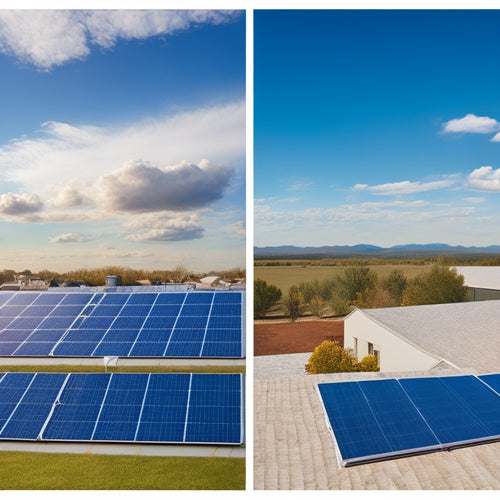
Maximize Energy Savings in Retail Operations
Share
You can maximize energy savings in your retail operations by conducting energy audits to identify areas of inefficiency and opportunities to reduce energy consumption and costs. Implement smart lighting control systems, optimize HVAC settings, and integrate renewable energy sources to minimize energy waste. Use advanced power management tools and real-time energy monitoring systems to track energy usage patterns and identify areas for improvement. By combining these strategies, you can substantially reduce energy consumption, lower energy costs, and minimize your environmental footprint. Now, take the next step to discover more actionable tips and cutting-edge solutions to optimize your retail operations' energy efficiency.
Key Takeaways
• Conduct energy audits to identify areas of inefficiency and opportunities to reduce energy consumption and costs in retail operations.
• Implement smart lighting control systems with occupancy sensors, timers, and dimming capabilities to optimize lighting energy usage.
• Use real-time energy monitoring systems to provide continuous updates on energy consumption and identify areas of inefficiency.
• Optimize HVAC settings, adjust lighting schedules, and implement energy-efficient equipment to reduce energy waste and consumption.
• Create a culture of sustainability by involving employees in energy-saving efforts and encouraging them to reduce energy waste in retail operations.
Energy Audits for Retail Spaces
Conducting an energy audit in your retail space is a key step in identifying areas of inefficiency and pinpointing opportunities to reduce energy consumption and costs. By doing so, you'll not only save energy but also increase your bottom line.
An energy audit provides a thorough assessment of your store's energy usage, highlighting areas where you can make adjustments to optimize energy efficiency. This process typically involves a meticulous examination of your lighting, HVAC, and refrigeration systems.
You'll also identify opportunities to take advantage of compliance incentives, such as rebates and tax credits, which can help offset the cost of energy-efficient upgrades.
In addition, involving your employees in the energy audit process can foster a sense of ownership and encourage them to take an active role in reducing energy waste. By engaging your employees, you can create a culture of sustainability that benefits both your business and the environment.
Smart Lighting Control Systems
By installing smart lighting control systems, you can harness advanced technologies like occupancy sensors, timers, and dimming capabilities to optimize your retail space's lighting energy usage and slash your energy bills by up to 50%.
With smart lighting, you can create customized schedules to guarantee lights are only on when needed, reducing energy waste. Occupancy sensors, a key component of smart lighting control systems, detect the presence of people in a room and adjust lighting levels accordingly.
This automation feature eliminates the need for manual switching, verifying that lights are turned off when not in use.
Lighting automation is a critical aspect of smart lighting control systems. By integrating lighting automation with occupancy sensors, you can achieve significant energy savings.
For instance, if a meeting room is unoccupied, the lights will automatically turn off, eliminating unnecessary energy consumption.
Additionally, smart lighting control systems can be integrated with your building management system (BMS) to provide a thorough energy management solution.
Energy-Efficient HVAC Solutions
As you explore energy-efficient HVAC solutions, you'll want to focus on system design optimization to guarantee your heating, ventilation, and air conditioning systems work in harmony.
This approach can substantially reduce energy consumption and lower your energy bills.
System Design Optimization
Optimizing your HVAC system's design can substantially reduce energy consumption and costs by ensuring that all components work together seamlessly and efficiently.
By doing so, you'll create a harmonious system that minimizes energy waste and maximizes savings.
To achieve this, you'll need to conduct a thorough load simulation to determine the precise cooling and heating requirements of your retail space.
This involves analyzing factors like occupancy rates, equipment usage, and external weather conditions.
Once you have a clear understanding of your energy demands, you can use system modeling to design an HVAC system that's tailored to your specific needs.
This might involve selecting equipment with the right capacity, configuring ductwork for efficient airflow, and integrating controls that enhance system performance.
Energy Recovery Systems
You can substantially reduce energy waste and expenses by incorporating energy recovery systems into your HVAC design, which harness waste energy and redirect it to improve overall system efficiency.
This innovative approach enables you to capitalize on energy that would otherwise be lost, thereby minimizing your environmental footprint and energy bills.
Heat recovery systems, in particular, are highly effective in retail operations where heating, ventilation, and air conditioning (HVAC) systems are constantly in use.
By capturing and reusing heat energy, you can notably reduce the load on your HVAC system, leading to substantial energy savings.
Energy harvesting technology takes this concept a step further by converting waste energy into usable electricity, which can power lighting, refrigeration, or other essential systems in your retail space.
Advanced Power Management Tools
Advanced power management tools, such as those integrated into modern operating systems, allow you to fine-tune your computer's energy consumption by setting specific power plans and profiles.
This level of control enables you to optimize energy usage during peak and off-peak hours, reducing your overall energy expenditure.
By leveraging predictive maintenance capabilities, you can identify potential equipment failures before they occur, minimizing downtime and reducing energy waste.
Energy forecasting tools also help you anticipate energy demand, ensuring you're prepared to meet peak energy requirements without overloading your systems.
By integrating these advanced power management tools into your retail operations, you can make data-driven decisions to maximize energy savings and reduce your environmental footprint.
With real-time energy monitoring and analytics, you'll be able to identify areas of improvement and optimize your energy usage to achieve significant cost savings.
Renewable Energy Sources Integration
As you explore renewable energy sources integration, you'll want to examine solar power systems that can substantially reduce your reliance on the grid.
By incorporating on-site energy generation, you can minimize your energy bills and carbon footprint.
Solar Power Systems
Solar power systems, which convert sunlight into electrical energy, offer a clean and sustainable alternative to traditional fossil fuels, making them an attractive option for those seeking to reduce their carbon footprint.
As you consider integrating solar power into your retail operation, you'll want to explore the concept of Grid Parity, where the cost of solar energy equals or falls below traditional electricity rates. This tipping point makes solar power a financially viable option.
You'll also want to look into Net Metering, a policy that allows you to generate your own electricity and export any excess to the grid, offsetting your energy consumption.
On-Site Energy Generation
By integrating on-site energy generation systems, you can substantially reduce your reliance on the grid and cut energy costs by leveraging a mix of renewable energy sources, including wind, geothermal, and biomass power.
This approach not only minimizes your carbon footprint but also provides a reliable and efficient way to power your retail operations.
Fuel cells, for instance, can be an effective on-site energy generation solution, particularly for smaller retail spaces.
These cells convert chemical energy into electricity, producing minimal emissions and operating quietly.
Additionally, microgrids can be designed to integrate multiple on-site energy generation sources, ensuring a stable and resilient energy supply.
Real-Time Energy Monitoring Systems
You can gain instant insights into your energy usage patterns with real-time energy monitoring systems, which provide continuous updates on your energy consumption.
This level of energy transparency allows you to identify areas of inefficiency and take corrective action quickly.
By leveraging data analytics, you can pinpoint specific times of day, week, or month when energy usage spikes, and adjust your operations accordingly.
For instance, you might discover that your energy consumption increases during peak shopping hours or during specific promotional events.
With this knowledge, you can implement strategies to reduce energy waste, such as optimizing lighting schedules, adjusting HVAC settings, or implementing energy-efficient equipment.
Real-time monitoring also enables you to track the effectiveness of your energy-saving initiatives, making it easier to refine your strategies over time.
Frequently Asked Questions
Can Energy-Efficient Upgrades Be Financed Through Utility Rebates?
You can leverage rebate incentives to finance energy-efficient upgrades, exploring financing options like utility-backed loans or performance contracts, which can help offset upfront costs and accelerate your project's ROI.
Do Energy-Saving Solutions Require Significant Changes to Operations?
You're wondering if energy-saving solutions require significant changes to operations. Fortunately, many solutions can be implemented with minimal disruption, ensuring operational readiness and business continuity.
How Do I Prioritize Energy-Efficient Upgrades for Multiple Locations?
You'll prioritize energy-efficient upgrades by conducting site assessments to identify opportunities, establishing energy benchmarks to track progress, and clustering locations by energy usage to tackle the most impactful projects first.
Will Energy-Efficient Solutions Impact Product Quality or Customer Experience?
You're right to wonder if energy-efficient solutions will compromise product quality or customer experience. Thankfully, most solutions won't impact either. In fact, they can enhance your supply chain and brand image, boosting customer trust and loyalty.
Can Existing Building Infrastructure Support Energy-Efficient Upgrades?
You assess your building's infrastructure capacity to determine its upgrade readiness, evaluating factors like electrical and HVAC systems, insulation, and windows to facilitate a seamless energy-efficient transformation.
Related Posts
-

Waterproofing Solar Panels for Vehicles: A Step-by-Step Guide
When waterproofing solar panels for your vehicle, start by evaluating your energy requirements and selecting the righ...
-

10 Best Solar Panel Options for Motorhomes Online
When choosing the best solar panel for your motorhome, consider factors like efficiency, durability, and design. You'...
-

Tracking Solar Panels Vs Fixed Panels Cost Savings
When considering solar panel options, you'll want to weigh the cost savings of tracking solar panels versus fixed pan...


